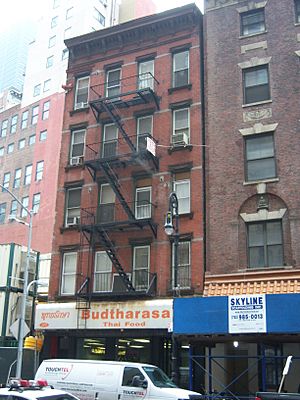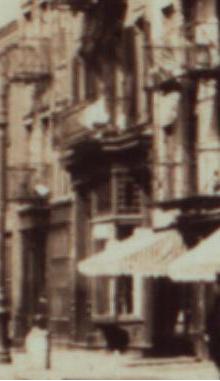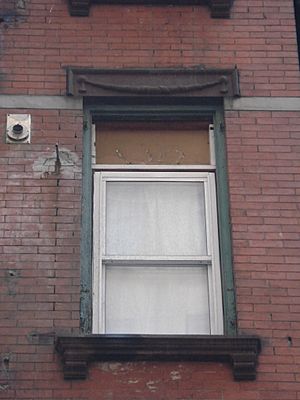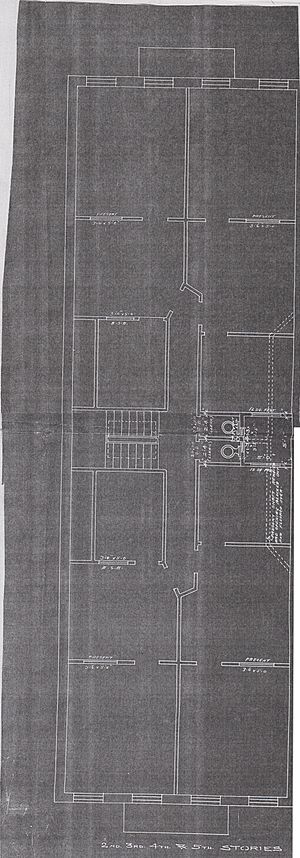109 Washington Street facts for kids
109 Washington Street is a five-story apartment building in the Financial District of Manhattan, New York City. It is located in an area once known as Little Syria. Many buildings in this area were torn down to build the Brooklyn–Battery Tunnel and the World Trade Center. Because of this, 109 Washington Street is now one of the last old apartment buildings on this part of Washington Street. Experts believe there were once about 50 such buildings here.
After the September 11, 2001 events, the building was close to the World Trade Center site. This made it the subject of some news stories. One radio story shared the experiences of its residents on that day. Today, community leaders and history lovers want to protect this building. They hope it can become a landmark as part of a small historic area. This area would also include St. George's Syrian Catholic Church and the Downtown Community House.
Contents
What Was Here Before?
Before the current building, a four-story brick "public store" stood at 109 Washington Street. This was as early as the 1820s. These stores received goods directly from the piers on West Street. They were places where goods were checked before going to shops.
In 1837, a fire happened at the store. The goods inside were worth about $300,000. These goods included lime juice, glass, wine, brandy, gin, and cordials.
By the 1850s, a residential building was on the property. Irish families lived there through the 1860s and 1870s. Later, in the 1870s and 1880s, German immigrants also moved in. People living there often worked as servants, sailors, cooks, or laborers.
What Are "Old Law" Tenements?
A tenement is a building with many apartments for more than three families. The first laws about tenements came out in 1867. Many early tenements were built on narrow lots in New York City. This meant apartments often had little light or fresh air.
Before 1879, most tenements were built with very few rules. After 1879, a new rule, called the "old law," changed their shape. Buildings became "dumbbell" shaped. They had narrow air shafts on the sides. These shafts were supposed to bring light and air to inner rooms. However, they often became places for garbage or spread fires. They also offered little privacy.
In 1901, new rules, called the "new law," made more improvements. These rules required better light for inner rooms. They also asked for slightly larger air shafts and indoor toilets. Many older tenements had to be updated to meet these new rules.
The "old law" tenements usually had four or five stories. They were made of red brick with stone or terra-cotta details around the windows. They often had a decorative metal cornice at the top. Newer "new law" tenements could be up to six stories tall.
In 1881, the old building at 109 Washington Street was sold. Lawrence O’Connor bought it in the same year. He lived nearby and worked at a liquor store. Many people who built tenements in the late 1800s were local business owners. They used their savings to buy land and become landlords. These owners, like O'Connor, often shared the same background as the people who would live in their buildings.
In 1885, O’Connor tore down the old building. He hired an architect named John P. Lee to build a new "old law" tenement. This new building had five stories. The ground floor had a storefront and a few apartments. The upper floors each had four three-room apartments.
Like most tenements built after the 1879 "old law," 109 Washington Street had 19 apartments. Each apartment had two windows in the largest room. Other rooms had little light or air. There was a narrow three-foot-wide airshaft on the south side. This was required by the 1879 law. There was no airshaft on the north side. This might be because the building next door had a small courtyard. This courtyard could provide some air and light.
Tenements further north on Washington Street, like No. 109, were seen as "better class." This was likely because they were newer. They were not converted warehouses like some older buildings. These "old law" tenements were typically low, red brick buildings. They had fire escapes on the front. Their apartments had three or four rooms. The back of the buildings often faced dark courtyards.
Like other tenements in Little Syria, 109 Washington Street had a business space on the ground floor. In the late 1910s, Pedro Caram, an immigrant from Syria, used the space. He exported goods like cotton, silk, and jewelry to South America. Later, in the 1920s, Leon Labe, another Syrian merchant, sold textiles there. He sold items like silk kimonos and sweaters to places like the Dutch West Indies and Brazil. By 1940, a glass seller occupied the ground floor.
Who Lived Here?
From the mid-1880s, many immigrants from the Middle East moved to Washington Street. However, 109 Washington Street mostly had Irish and German immigrants. By 1900, 37 people lived at 109 Washington Street. About 75% were Irish or first-generation Irish-American. The rest were German or first-generation German-American. Most men worked as laborers or truck drivers. Women often worked as cleaners in nearby office buildings.
By 1905, about 60% of the families on the block were Syrian immigrants. Greeks and Egyptians also moved into the area. But 109 Washington Street still had residents of Irish, Hungarian, or Austrian backgrounds.
By 1910, the number of people living at 109 Washington Street doubled to over 60. Families from Austria-Hungary, Ireland, Scotland, Russia-Lithuania, Italy, and Slovakia took in boarders. This increase might be due to more immigrants arriving in New York. It could also be because the building was improved in 1907.
By 1920, only one original Irish family remained. New immigrants from Slovakia, Poland, and Russia moved in. Throughout the 1920s and 1930s, the building was home to Czech-Slovak, Irish-American, Polish, and German families. They worked in various jobs like elevator operators, dishwashers, and waiters.
In 1940, fewer people lived in the building, only 40. This might show that the neighborhood was changing. Residents came from Czechoslovakia, Poland, Yugoslavia, and the United States. They worked as porters, salesmen, and bakers. Women often worked as office cleaners or waitresses.
109 Washington Street was a typical tenement in Little Syria. It housed hundreds of people from over thirteen different countries in its first 60 years. These included people from Austria, Slovakia, Scotland, Ireland, Hungary, Russia, Lithuania, Italy, Poland, Czech Republic, Germany, Yugoslavia, and America.
Building Design
In the 1910s, 109 Washington Street was one of the taller and newer buildings on the street. It had a bay window storefront made of metal and glass. The architect, John P. Lee, was likely very familiar with tenement buildings.
The building at 109 Washington Street has five stories and is made of brick. It was built in 1885 as a residential building. The original windows were likely double-sash windows. They had sills and lintels (parts above and below the window) that looked like brownstone. These had simple decorative designs.
The building also has a painted metal cornice at the top. This matches a metal "belt course" just below it. Both are painted brown to look like cast iron. These details were probably bought from building supply yards. But the small decorations show a desire to make the building look nice.
A strip of slate or bluestone runs along the top of the windows on each floor. A fire escape has been on the building since before 1907. Fire escapes were often used to air out blankets, dry laundry, or store large items.
The apartments at 109 Washington Street had three rooms. There was a front room (parlor) with windows. A kitchen was in the middle. A small bedroom was in the center, near the stairs. You entered each apartment through the kitchen. The main entrance on the ground floor was on the north side. Stairs were reached through a long, narrow hallway.
The building has been changed twice. When built in 1885, it was meant for 19 families. Around 1900, about 35 to 40 people lived there. By 1910, the number doubled to 67 people.
In 1907, the building was updated to meet the 1901 Tenement House Law. John J. O’Connor, a relative of the owner, did the work. Changes included adding two shared toilets on each floor. Windows were also added to inner walls for light and air. Later, the outside windows were replaced. The original metal and glass storefront was also changed.
The O’Connor family owned the tenement for over 70 years. In 1955, they sold it. The new owner made more improvements. The ground floor store became a deli. New toilets were added on each residential floor. The ground floor has been a food place ever since. It has housed places like Marino's Pizza and now Budtharasa Thai Food. Except for the changed windows and storefront, the building still looks much like it did over a hundred years ago.
September 11, 2001
Because 109 Washington Street was so close to the World Trade Center, its residents had a unique experience on September 11. This experience received media attention. In 2003, a radio program called "109 on 9-11: An Audio Documentary" shared memories from the building's residents.
Efforts to Protect the Building
Many old buildings in the neighborhood were torn down. Because of this, current and former residents, along with history lovers, want to protect 109 Washington Street. They want it to be named a New York City landmark.
Community Board One has asked the New York City Landmarks Preservation Commission to hold a meeting about this. In 2011, a group called Save Washington Street sent letters to the Commission. This group included Arab-American organizations, other groups, and history experts. They encouraged the Commission to hold hearings on the building. In October 2011, the Place Matters organization gave 109 Washington Street one of its "Places That Matter" awards.





